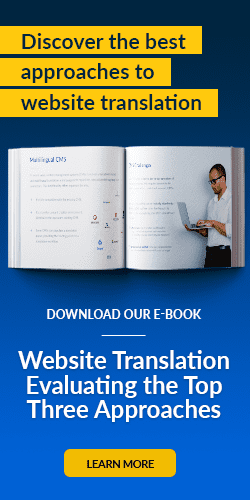When companies choose to expand into new global markets online, they often face two primary challenges:
- Generating brand awareness among local consumers
- Converting site visitors into paying customers
This blog post will focus on practical ways to address these challenges in ways that generate immediate and sustained growth for your business, in online markets around the world.
Generating Brand Awareness
We've long said that the most elegant and expedient way to smartly serve consumers in global markets is to provide websites in their preferred languages. Time and again, we've seen traffic, engagement and revenue surge when customers visit websites that are published and optimised in the languages they speak.
Your brand can create great websites that provide exceptional user experiences, but if local consumers have never heard of your brand—for instance, if your company doesn’t have a local brick-and-mortar presence in-market—you’ll experience challenges in driving users to your site.
Based on our years of insight and experience, companies should leverage translated, localised Pay-Per-Click (PPC) campaigns to attract locals. These PPC adverts should be placed on regionally-appropriate search engines, too. (For instance, Yandex is the No. 1 search engine for Russia; Naver is the primary search engine for South Korea.)
We've helped retailers promote their new global e-commerce sites with in-language, targeted digital advert campaigns. One campaign drove 20,000 consumers to a Dutch site during its all-important first month in market.
Leveraging translated content in interesting ways—like reusing such content on local social networks—also helps move the needle, we’ve found.
Managing localised email newsletters for these markets is another way to generate interest and online engagement.
Managing localised email newsletters for these markets is another way to generate interest and online engagement. We've seen an airline experience a nearly 45% increase in revenue during holiday promotions, thanks to a local, in-language email marketing campaign. A retailer serving South Korea saw traffic skyrocket over 350%, and transactions grow ten-fold, thanks to savvy email outreach.
MotionPoint's platform also features several proprietary technologies to help customers find your translated, localised websites:
- EasyLink® Management smartly examines your inbound shoppers’ preferences, and presents an online experience in the language they’re most likely to speak. (With EasyLink, site visits increase an average of over 80%.)
- Global Sitemap Management, which leverages the power of the “hreflang” attribute, ensures that the proper translated version of your website appears in organic search results.
Converting Site Visitors
Once your new customers have found your local website, the next challenge begins: keeping them there, and convincing them to become paying customers (or convert in other meaningful ways). We’ve found the best way to woo these consumers is with authentic online experiences, featuring messaging, phrases and promotions that create lean-in within local markets. This often requires a more artful hand than word-for-word translation; it usually requires localisation-using terms that resonate within specific markets or subcultures.
Localisation goes a long way to improve brand awareness and trust among local consumers. This online content often feels authentic, crafted by a native.
MotionPoint offers a powerful service called Market Management to help companies accomplish this goal. Market Management customises elements of a website (such as a promotional banner, or certain phrases) with super-relevant translated content.
Here's a recent example. MotionPoint used Universal Spanish (an easily-understood "region-neutral" flavour of the language) in the translation of a travel client's Latin American website. These translations were perfect, but they weren't clicking with consumers. We opted to localize key webpages and phrases for Latin Americans, using locally-preferred lingo. A month later, site impressions grew by 75%, and search-engine rankings improved by 11 positions.
Using Market Management technology, we helped another global retailer generate 25% higher conversions on its Moroccan website, thanks to a localised Arabic message timed to a religious holiday. We helped another retailer overcome a critical credibility gap in the U.S. market; after we provided customised, trust-building messaging to consumers in the checkout funnel, checkout rates grew over 25%.
This approach is successful, regardless of industry or language. Not long ago, MotionPoint crafted creative, localised translations for an airline operating a site for South Korean customers. After these localizations were published, click-throughs increased by an average of 15%. Checkouts rose by nearly 45%. One promotion generated a nearly 30% jump in clicks, and a nearly 70% increase in checkouts.
Customers will quickly bail from transactional websites when their preferred payment methods aren’t available.
But customised messaging and promotions aren't the only tactics at a company's disposal. Our proprietary research, complemented by reputable third-party data, reveals that customers will quickly bail from transactional websites when their preferred payment methods aren’t available. The attrition rate can be brutal: in South Korea, global brands can lose out on 80% of sales when they don’t support local payment platforms.
The solution, naturally, is to research local markets, determine their preferred payment methods, and provide them-and advertise them-on-site. We recommend clearly displaying their logos or other signifiers on page footers, and on the main checkout page (at the top of the checkout funnel).
Note that when it comes to digital payments, not all markets are created equal. It's no secret U.S. consumers make most online purchases with a credit or debit card. Not so in China, where the preferred platform is a PayPal-like service called Alipay. And while the trend is slowly changing, Russians prefer to pay with cash, on delivery. (This logic also works in reverse: If you're a Chinese company expanding into a Western market, don't assume consumers there have Alipay accounts.)
Note that when it comes to digital payments, not all markets are created equal.
At MotionPoint, we guide our customers through these tricky situations. When a Western retailer took our advice and supported Alipay on its new Chinese site, revenue and conversion grew by 210%. Average order size rise by 33%.
When we noticed certain payment types weren't prominently displayed on another customer's French and German websites, we recommended some changes. After implementation, French conversion rates rose over 135%. German conversions grew by over 265%. Revenue gains went through the roof.
Wrapping Up
MotionPoint's powerful and flexible platform delivers far more than world-class translations for your global websites. Our team develops technologies to ensure your online moves in-market deliver immediate and sustained success, with a keen eye toward ROI.
Want to learn more about how we can help your business grow? Contact us for more information.
Last updated on January 31, 2017
